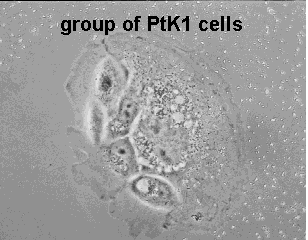[See
ref 7
]
Cells can migrate in groups
Most epithelial cells migrate very little in tissue culture, and if they collide with other
epithelial cells they stay together. However, this does not mean that a group of epithelial cells
is also a slow mover. For example, I found that PtK1 cells can migrate in groups that are much faster
than the single cells. As illustrated in the figure below, the tracks of single cells are much
shorter than the tracks of a group migrating for the same length of time.
In addition, the figure on the right hand side shows one of the migrating groups in scanning electron microscopy to illustrate that the group does not
fuse the cells into one large syncitium, but conserves the individuality of the member cells.

Group migration is not a tug-of-war
The simplest explanation for group migration of cells would be a tug-of-war:
The strongest cells pulls against the others and thus determine a resultant direction.
However, this explanation cannot apply in the case of migrating PtK1 groups. Obviously,
if cells in a group pull in opposite directions, they will slow each other down. Thus, the group can
never move faster than its members migrating alone. In contrast, PtK1 cell groups are faster than their members.
There is another important difference. The direction of a group in a tug-of-war would fluctuate
soemwhat randomly depending on the superimposition of opposing forces from one moment to the other.
As shown in the live cell sequence below, that is not the case for PtK1 groups, either.

(The illustration is animated.Click here for a minimal strip of frames.)
The actions of the individual cells appear highly coordinated with each other. Some cells even
appear to turn their bodies into a single leading edge of the group while the bodies of other
cells turn themselves into a tail of the group. This division of labor between members of the
group resembles very much the division of labor between different domains of a single migrating
fibroblast.
Significance for cell intelligence:
Cells can communicate about each other's 'programs of movement'.
Since groups of PtK1 cells are able to migrate faster than single cells, they must have
stimulated each others' motility control systems. In addition, they seem to coordinate their shape
changes in such a way that the whole group migrates directionally, often accompanied by the
formation of leading fronts and tails. Therefore, the motility control systems appears to
be able communicate with each other about about shape changes, direction and timing.


